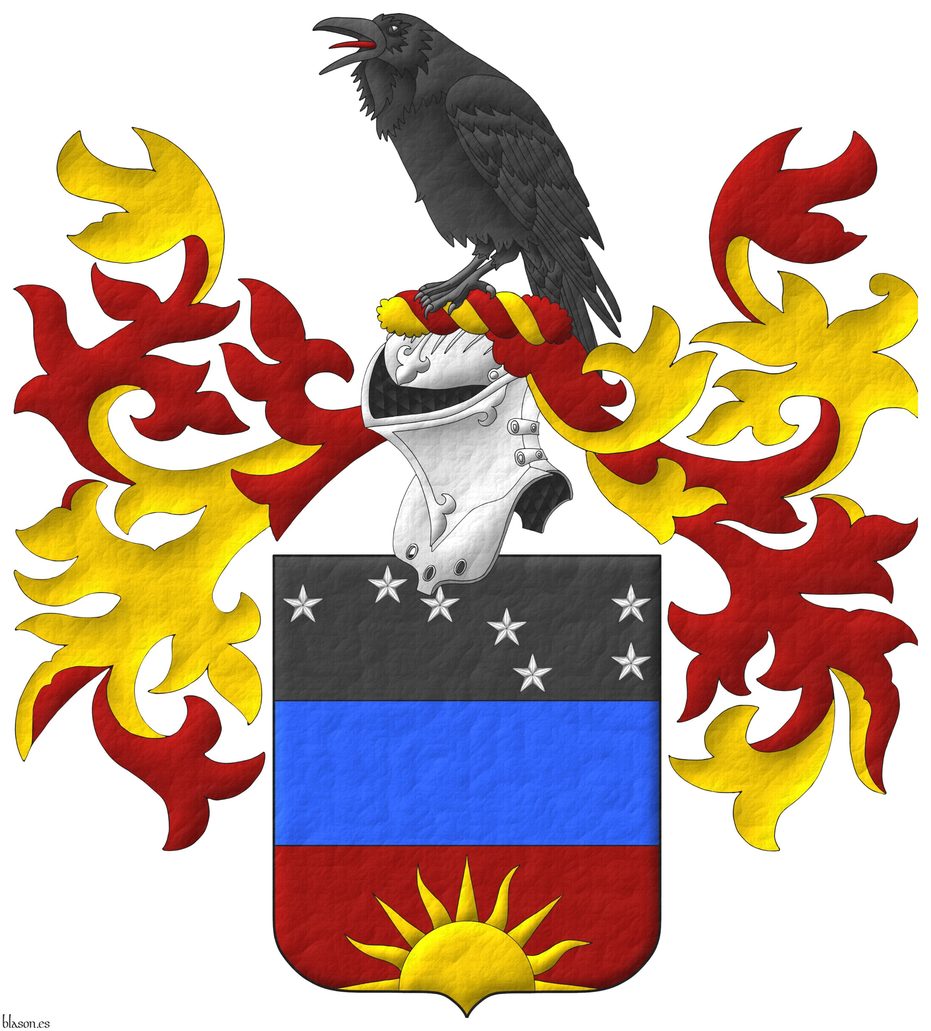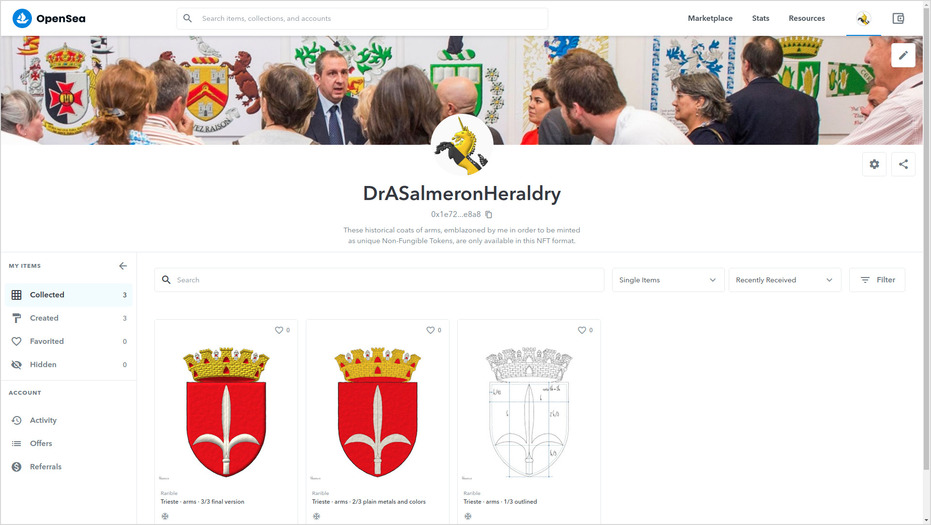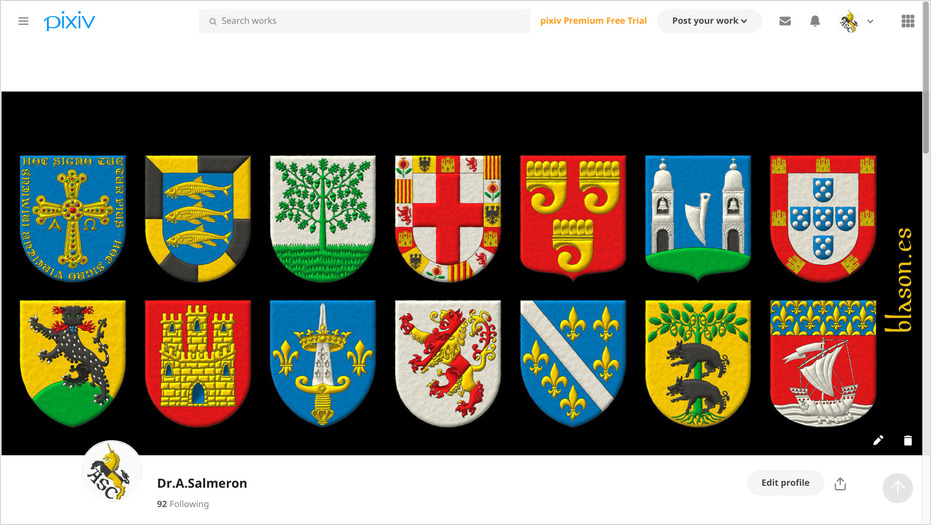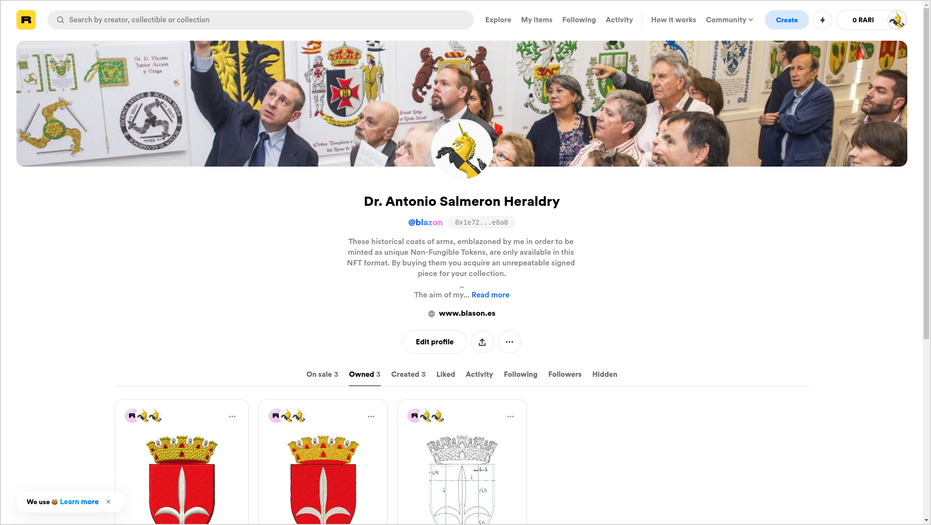Issuant from base


Ignasi Pujol, comparation
[ Azure, a mount issuant from the base, in chief a fleur the lis Argent ] and [ Party per chevron Azure and Or, in chief a fleur de lis Argent, in base four pallets Gules ].
The coat of arms of Ignasi Pujol was designed by him based on the ancient arms of the Pujol lineage, 1st image, and refined and emblazoned by me, 2nd image. The comparison of the blazon of the Pujol lineage with the blazon for Ignasi Pujol is the following.
Blazon keywords: Azure, Argent, Or, Gules, One, Mount, Issuant from base, In chief, Party per chevron, Fleur de lis, In base, Pallet and Pale.
Style keywords: Outlined in sable and Illuminated.
Classification: Lineage, Personal, Compare, Interpreted, Coat of arms and Boa.
Bearer: Pujol, Ignasi.


Motto of Tomasz Arkadiusz Grzeszkowiak
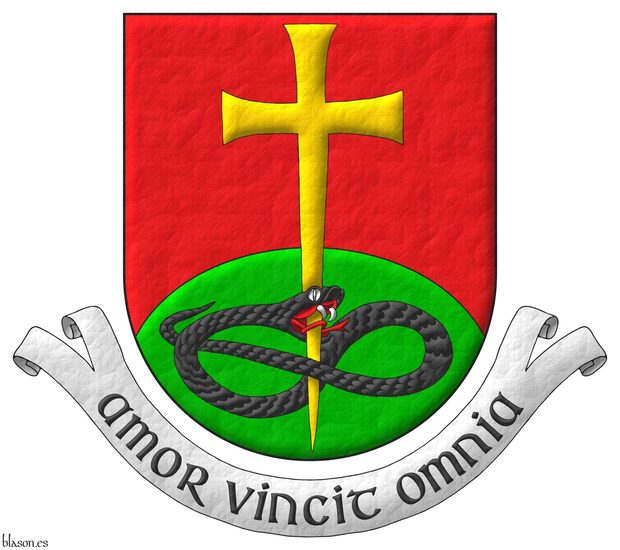
Gules, a base enarched Vert, overall a cross patty fitchy Or, piercing in base the head of a serpent nowed and facing sinister Sable, langued Gules. Motto: «Amor vincit omnia»
Blazon keywords: Without divisions, Gules, One, Mount, Vert, Issuant from base, Overall, Cross patty fitchy, Cross couped, Piercing, Head, Serpent, Nowed, Facing sinister, Sable, Langued and Motto.
Style keywords: Semi-circular, Leather and Outlined in sable.
Classification: Interpreted, Personal and Coat of arms.
Bearer: Grzeszkowiak, Tomasz Arkadiusz.


Pons Paneque, Jonathan
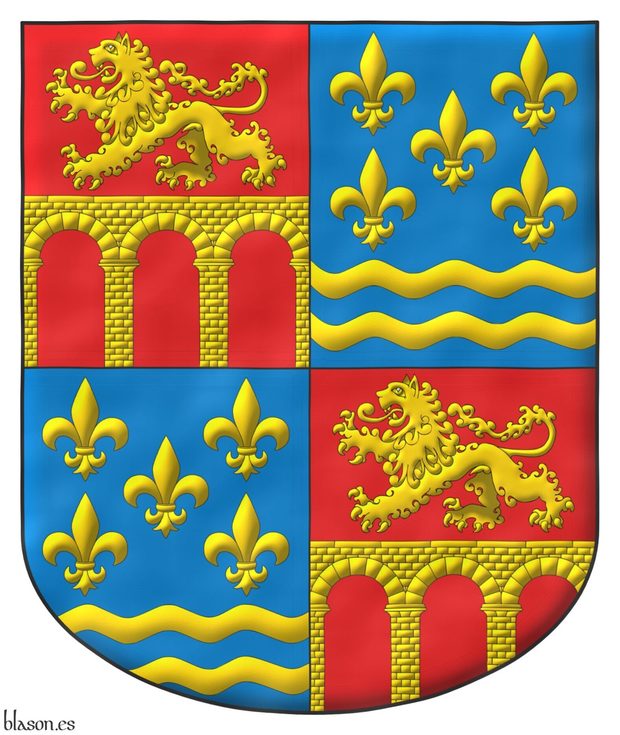
Quarterly: 1 and 4 Gules, a three arch bridge issuant from base and throughout Or; 2 and 3 Azure, five fleurs de lis, in base two bars wavy Or.
Escudo cuartelado: 1o y 4o de gules, un puente de tres ojos moviente de la punta y los flancos de oro; 2o y 3o de azur, cinco flores de lis, en punta dos fajas ondadas, todo de oro.
Coat of arms emblazoned by me with a shape ended with an rounded arch, illuminated, and its finishing is that seems watercolor.
Credits:
- Felipe Trujillo Jiménez is the designer of the coat of arms.
- Antonio Salmerón y Cabañas is the author of the heraldic art.
Blazon keywords: Quarterly, Gules, One, Bridge, Issuant from base, Throughout, Or, Azure, Five, Fleur de lis, In base, Two, Fess and Wavy.
Style keywords: Pointed, Outlined in sable, Illuminated and Watercolor.
Classification: Personal, Interpreted and Coat of arms.
Bearer: Pons Paneque, Jonathan.


Barrio Alto of Mon'Tarena, motto

Gules, on a trimount issuant from the base Argent a bighorn sheep salient Or, horned Argent. Motto: «Barrio Alto» Sable with initial letters Gules over a scroll Argent.
Escudo de gules, un monte de tres peñas moviente de la punta de plata sumado de un borrego cimarrón saltante de oro, acornado de plata. Divisa: «Barrio Alto» de sable, con iniciales de gules, sobre una filacteria de plata.
Arms designed by me, illuminated with lights and shadows, contoured in Sable, with a chasuble outer contour and with a watercolor finish.
The coat of arms of the Barrio Alto of Mon'Tarena, Queretaro, Mexico, designed by Joaquin Haces Perdomo and me and emblazoned by me. In this case, the tinctures Gules, Or and Argent have been adjusted to match the official colour palette of Mon'Tarena.
Blazon keywords: Gules, Or, Argent, Sable, One, On, Trimount, Issuant from base, Bighorn sheep, Salient, Horned, Motto and Scroll.
Style keywords: Outlined in sable, Illuminated, Chasuble and Watercolor.
Classification: Civic, Created, Boa and Coat of arms.
Bearer: Barrio Alto of Mon'Tarena.


Amitay Edward von Stiebel, outlined

Quarterly: 1 Or, a lion rampant, facing sinister Sable, armed and langued Gules; 2 and 3 Gules, an anchor proper; 4 Or, a lion rampant Sable, armed and langued Gules; overall, a pile issuant from base Azure charged with a mount proper issuant from water issuant from base Argent, in chief, a mullet of six points Or.
Coat of arms of Amitay Edward von Stiebel outlined by me.
Blazon keywords: Or, Sable, Gules, Azure, Argent, One, Six, Quarterly, Lion, Rampant, Facing sinister, Armed, Langued, Anchor, Proper, Overall, Pile issuant from base, Charged, Mount, Issuant, Water, Issuant from base, In chief and Mullet.
Style keywords: Outlined and Bull's hide.
Classification: Personal, Interpreted, Boa and Coat of arms.
Bearer: Stiebel, Amitay Edward von.


Graaf, Jay Geoffrey De

Party per fess, 1 Gules, a stag rampant, issuant from base proper, in the dexter chief a Maltese cross Argent; 2 Azure, a mullet of seven points Argent.
Escudo cortado: 1o de Gules, un ciervo rampante, moviente de la punta al natural, en la diestra del jefe, una cruz de Malta de plata; 2o de azur, una estrella de siete puntas de plata.
Coat of arms emblazoned by me, illuminated with lights and shadows, contoured in Sable, with a pointed outer contour and with a freehand finishing.
G0131, augmentation of G0042, Chief Herald of Arms of Malta's grant of the coat of arms of Jay Geoffrey De Graaf, Australia. The augmentation consists of the addition of a Maltese cross Argent in the dexter chief. This coat of arms has been emblazoned by me.
Blazon keywords: Gules, Azure, Argent, One, Party per fess, Stag, Rampant, Issuant from base, Proper, In the dexter chief, Eight-pointed cross, Cross couped and Mullet.
Style keywords: Outlined in sable, Illuminated, Pointed and Freehand.
Classification: Personal, Interpreted, Boa and Coat of arms.
Bearer: Graaf, Jay Geoffrey De.


Crest and mantling of Marcio Vieira Nastri
Tierced per fess: 1 Sable, seven mullets Argent arranged as the Plough of Ursa Major; 2 Azure; 3 Sanguine, a demi-sun issuant from base Or. Crest: Upon a helm with a wreath Or and Sanguine, a raven proper. Mantling: Sanguine doubled Or.
Coat of arms emblazoned by me, highlighted with lights and shadows, contoured in Sable, with an ogee outer contour and with a leather finishing.
Blazon keywords: Sable, Azure, Sanguine, Argent, Or, Seven, One, Tierced per fess, Mullet, Plough of Ursa Major, Demi, Sun, Issuant from base, Crest, Upon (wreath), Helm, Wreath, Raven, Proper and Mantling.
Style keywords: Outlined in sable, Illuminated, Ogee and Leather.
Classification: Personal, Interpreted, Boa and Coat of arms.
Bearer: Nastri, Marcio Vieira.


Arturo Taborda, plain tincture

Azure, issuant from base a frog's head and from flanks its forelegs in chevron Or, in chief a mullet of seven points Argent.
Arms depicted by me, in plain tinctures, contoured in Sable, with an ogee outer contour and with a texturized finish.
Coat of arms of Arturo Taborda, Venezuela, emblazoned by me.
Blazon keywords: Azure, Or, Argent, One, Seven, Issuant from base, Frog, Head, Flank, Foreleg, In chevron, In chief and Mullet.
Style keywords: Outlined in sable, Plain tincture and Ogee.
Classification: Personal, Interpreted, Boa and Coat of arms.
Bearer: Taborda, Arturo.


OpenSea
My heraldic NFTs in OpenSea opensea.io/DrASalmeronHeraldry.
These historical coats of arms, emblazoned by me in order to be minted as unique Non-Fungible Tokens, are only available in this NFT format. By buying them you acquire an unrepeatable signed piece for your collection.
Categories: Technology, Social networks, NFT, Gules, Halberd, Issuant from base and Argent.


Pixiv
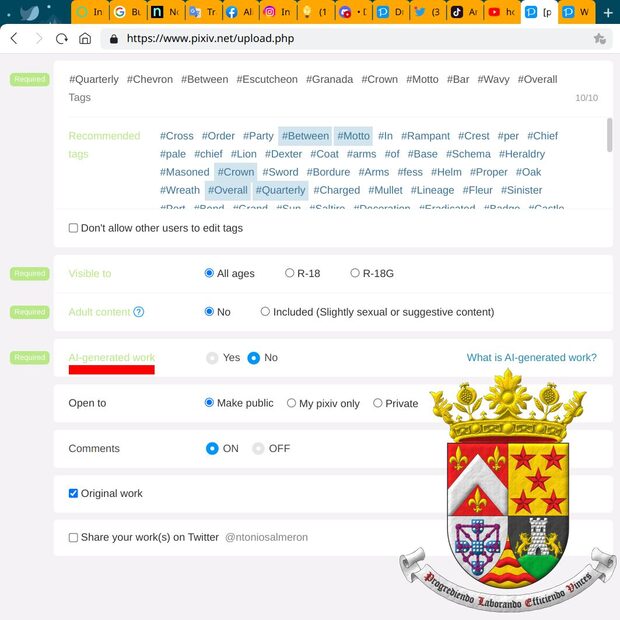
My heraldic Pixiv wall is Dr.A.Salmeron @antoniosheraldry and pixiv.me/antoniosheraldry.
Pixiv is a Japanese online community for artists. I post in Pixiv 2 or 3 coats of arms per week. They use a strict form to post with many mandatory input fields. This week, they have added a new mandatory field «AI-generated work: Yes / No», AI ~ Artificial Intelligence. In the image, I have highlighted this new field in red.
Categories: Technology, Social networks, Quarterly, Gules, One, Chevron, Argent, Between, Three, Fleur de lis, Or, Five, Mullet, In saltire, Four, Escutcheon, In cross, Azure, Charged, Nine, Bezant and plate, Two, Flank, Fesswise, Center, Overall, Carbuncle, Cord, In orle, Knotted, Purpure, Overall (all), Sable, Mount, Issuant from base, Vert, On, Tower, Port and windows, Masoned, Wolf, Supporting, Enté en point, Fess, Wavy, Crown of the Sovereign and Most Noble Order of the Pomegranate, Crown and Motto.


Rarible
My heraldic NFTs at Rarible rarible.com/blazon.
These historical coats of arms, emblazoned by me in order to be minted as unique Non-Fungible Tokens, are only available in this NFT format. By buying them you acquire an unrepeatable signed piece for your collection.
Categories: Technology, Social networks, NFT, Gules, Halberd, Issuant from base and Argent.

Nhf, Norsk Heraldisk Forening
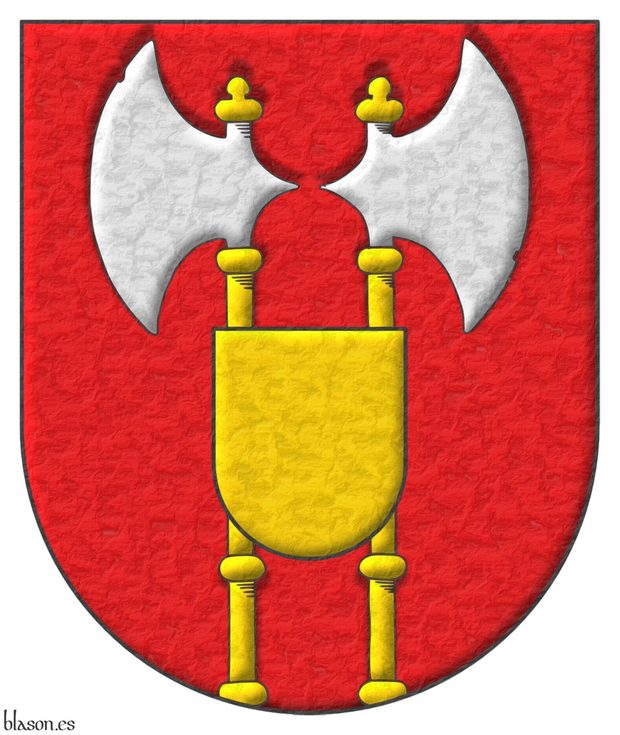
Gules, two Axes Argent, hafted Or, addorsed, issuant from the base; overall, at the nombril, an Escutcheon Or.
Escudo de gules, dos hachas adosadas de plata, fustadas de oro, movientes de la punta; brochante sobre el todo, en el ombligo, un escudete de oro.
Coat of arms interpreted with: the semicircular shape; its field illuminated with Gules; its figures and escutcheon illuminated with Or and Argent and outlined in Sable; and with a free hand texture.
At the nombril
A distinctive feature of this coat of arms is that its escutcheon, instead of being overall in the center, is positioned on a point of the coat of arms called the nombril, which, as we learn from [Avilés, J.; 1725a; page 159 and illustration 19] and also [Avilés, J.; 1780a; pages 147 and 148], in «Heraldry, the nombril of the coat of arms, is the place through which the human body receives nourishment in the mother's womb, and in the shield, it corresponds to the point where the fess ends and the base begins.».
If this escutcheon, «escudete» in Castilian, had been positioned in the center of the coat of arms, then it would have to be blazoned as the piece called an inescutcheon, «escusón» in Castilian. In fact, the Norsk Heraldisk Forening uses the English term «escutcheon» to describe the blazon of its arms.
Blazon keywords: Without divisions, Gules, Axe, Argent, Hafted, Or, Addorsed, Issuant from base, Overall, At the nombril and Escutcheon.
Style keywords: Semi-circular, Illuminated, Outlined in sable, Shaded and Soft metal.
Classification: Interpreted, Socioeconomic and Coat of arms.
Bearer: Norsk Heraldisk Forening.
-
Language
-
Categories of heraldry
-
Divisions of the field
- Without divisions
- Party per pale
- Party per fess
- Party per bend sinister
- Tierce
- Tierce sinister
- Tierced per fess
- Tierced per bend
- Tierced pallwise inverted
- Quarterly
- Quarterly per saltire
- Gyronny
- Party per fess, the chief per pale
- Party per pale, the sinister per fess
- Party per fess, the base per pale
- Party per pale, the dexter per fess
- Chapé
- Chaussé
- Party per chevron
- Enté en point
- Flanched
-
Metals
-
Colours
-
Furs
-
Other tinctures
-
Ordinaries and sub-ordinaries
-
Diminutives of the ordinaries
-
Other charges
-
Charges from Nature
Water, Eagle, Bald eagle, Eagle claw, Dorsal fin, Tail fin, Two hands clasped, Lark, Tree, Trunk, Rainbow, Atom, Barbel, Acorn, Bighorn sheep, Arm, Owl, Vulture, Horse, Head, Goat, Camellia, Thistle, Merino ram, Kapok tree, Stag, Doe, Crescent, Increscent, Chrysanthemum, Tail, Tail addorsed, Ermine spot, Hummingbird, Snowflake, Heart, Roe deer, Neck, Roe deers' attires, Raven, Dolphin, Diamond, Tooth, Elephant, Emerald, Starling, Mullet, Mullet of four points, Star of David, Estoile, Male figure, Fleur de lis, Flower, Cornflower, Dogwood flower, Lotus flower, Hop cone, Bluebonnet, Puffin, Ash, Rooster, Claw, Talon, Goose, Heron, Seagull, Pomegranate, Sunflower, Swallow-tail, Falcon, Leaf, Boar, Goldfinch, Laurel, Barn owl, Lion, Lioness, Lion passant, Leopard, Lion rampant guardant, Lynx, Lily, Madonna lily, Flame, Wolf, She-wolf, Parrot, Moon, Hand, Apple, Apple tree, Martlet, Wing, Two wings in vol, Covert, Blackbird, Mount, Trimount, Fly, Wrist, Elm, Olive tree, Orbital, Bear, Palm frond, Palm tree, Dove, Poplar leaf, Panther, Jaguar, Vine, Paw, Forepaw, Foot (palmiped), Foreleg, Peacock, Chest, Pelican, Pelican in her piety, Dog, Brach hound, Fish, Hoof, Beak, Quill, Cinquefoil, Quetzal, Branch, Sprig, Frog, Shamrock, Caboshed, Oak, Holm oak, Rose, Double rose, Savage, Serpent, Plough of Ursa Major, Sun, Sun in splendour, Ray of the sun, Lightning flash, Stem, Badger, Tyger, Linden, Wheat, Wheat spike, Bull, Tulip, Udder, Escallop and Fox.
-
Artificial charges
Halberd, Plough share, Ace of spades, Anchor, Cyclamor, Torch, Bow, Arch, Harp, Non-classic artifact, Winnowing fan, Crozier, Conductor's baton, Pair of scales, Ship, Norman ship, Beret, Grenade, Ecclesiastical cap, Arm vambraced, Knight, Chain, Covered cup, Monstrance, Bell, Bell tower, Cannon dismounted, Carbuncle, Castle, Ribbon, Clarion, Nail, Cord, Dagger, Key ward, Turret, With a turret, Armillary sphere, Sword, Federschwert, Sabre, Parchment, Scroll, Arrow, Club, Garb, Sheaf of tobacco, Scythe, Gauntlet, Axe, Buckle, Galician granary, Polish winged hussar, Church, Oil lamp, Spear, Spear's head, Fleam, Letter, Book, Open book, Closed book, Bookmark, Page, Line, Lantern, Key, Four crescents joined millsailwise, Hammer, Menorah, Mortar, Pestle, Number, Knot, Celtic Trinity knot, Water-bouget, Comb, Piano, Millstone, Millrind, Millwheel, Clay pot, Bridge, Cuffed, Hourglass, Chess rooks, Compass rose, Rosette of acanthus leaves, Mullet of six points pierced, Broken, Portcullis, Wheel, Wagon-wheel, Symbol, Sackbut, Drum, Geometric solid, Tetrahedron, Tower, Trident, Trumpet, Double vajra and Anvil.
-
Immaterial charges
Angel, Heart enflamed, Sacred Heart of Jesus, Paschal lamb, Dragon, Wyvern, Phoenix, Garuda, Griffin, Sea-griffin, Winged hand, Our Lady of Mercy, Pegasus, Saint George, Mermaid, Trinity, Triton, Golden fleece, Unicorn and Ouroboros.
-
External elements
-
Heraldic creations
-
References
-
Formats
-
Keywords on this page
Port and windows, Between, Watercolor, Proper, Halberd, Facing sinister, Pointed, Azure, Boa, Overall, Head, Charged, Five, Ogee, Cross couped, Quarterly, Outlined in sable, Two, In chief, In base, Escutcheon, Coat of arms, Mullet, Fess, Flank, Fleur de lis, Personal, Gules, Illuminated, Interpreted, Langued, Motto, Semi-circular, Mount, Issuant from base, NFT, Wavy, Or, Leather, Argent, Without divisions, Rampant, Social networks, Sable, Seven, Vert, On, Technology and One.
![Ignasi Pujol, comparation [ Azure, a mount issuant from the base, in chief a fleur the lis Argent ] and [ Party per chevron Azure and Or, in chief a fleur de lis Argent, in base four pallets Gules ].](../escudo_armas/PujolIgnasi.20.PujolLineage.Ogee.Compare.jpg)
